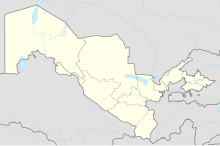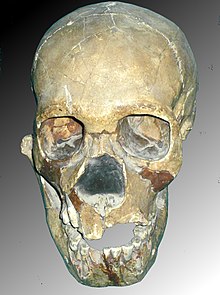Teschik Tash Cave
Coordinates: 37 ° 58 ' N , 67 ° 9' E
The Teschik-Tash Cave ( Russian Пещера Тешик-Таш , Uzbek Teshik-Tosh - stone with hole) is an archaeological site in the Baisuntau Mountains, in the Uzbek province of Surxondaryo .
On July 4, 1938, the Soviet archaeologist Alexei Okladnikow found 70,000-year-old skeletal remains of an eight- to ten-year-old Neanderthal child in Teschik-Tasch . Mostly referred to in the literature as the boy from Teschik-Tasch, the partial skeleton is, according to recent studies, the remains of a girl. The skeletal remains were embedded in the ground in such a way that an intentional positioning of the body in this position can be assumed and a possible burial can be spoken of. However, this interpretation is controversial.
location
The Teschik Tasch Cave is located 125 kilometers south of Samarkand and 24 kilometers south of the city of Baisun, in the Baisuntau Mountains, the southwestern foothills of the Hissar Mountains at an altitude of 1,600 meters above sea level . The cave lies at the bottom of a narrow, only 15 to 20 meters wide, with steep 40 to 50 meter high, partially overhanging rock walls, called Sautoloschsaja, which starts from the left bank of the Turgan-Darja river.
description
The cave entrance is oriented to the northeast. The Teschik-Tasch Cave consists of a 20-meter-wide and 7-meter-high chamber at the entrance, which extends 21 meters below the surface.
Five separate settlement layers and a dozen fire pits, some with clusters of broken bones and horns of wild goats , bones of other animals, as well as stone chips and other tools, could be found in the Teschik-Tash cave. In the northwestern part of the cave, about 10 meters from the entrance, near the western cave wall, there were the skeletal remains of a child. The partial skeleton, colored yellow by the surrounding sediment, lay in the top of five Moustérien culture layers at the site, with its feet facing the entrance to the cave in a shallow pit.
The skull was crushed by the weight of the sediment above. Nevertheless, it was so well preserved that it could be reconstructed from around 150 pieces. The skull showed the anatomical features of the Neanderthals: face with a large nose area , the beginning of a browbrow, a receding forehead , a long cerebral skull and a low lower jaw without a protruding chin. The brain had a volume of about 1,500 cubic centimeters.
Several postcranial bones were scattered around the skull in a non-anatomical context, a cervical vertebra , several ribs , the left humerus , the collarbones , the right femur , the left shin and the two fibula bones . The ends of the humerus and thighbones were gnawed off. Next to the skeleton was a coprolite ; perhaps a beast of prey was rummaging through the grave, took out some bones and gnawed at them.
The most striking thing about the grave were six pairs of large bone cones from the horns of Siberian ibexes , which were arranged in a circle around the skull with the point downwards. The horns were partly whole and partly broken. Two were still attached to the forehead of the skull, three or four pairs had been separated from the forehead in the pit. All the horns were tipped into the ground and arranged in one direction - they formed a kind of fence at the top of the grave and lay in the same layer and depth as the child's skull. A fire had burned next to the body for a short time.
classification
Although there is some evidence that the child was buried with the horns of the ibex near a fireplace, there are doubts as to whether the pairs of horns can be interpreted as a grave. Teschik-Tasch remains controversial as an example for burials of Neanderthals, especially due to the references to disturbances of the site by predators, the possibly resulting fact that the skeleton was not in the anatomical association and the lack of evidence of a clear grave pit.
The child from Teschik-Tasch was probably even more closely related to the European Neanderthals than the early humans from Siberia . Until the discovery of the Okladnikow Cave 2000 kilometers further east, it marked the eastern border of the known distribution area of the Neanderthals.
The Russian archaeologist Mikhail Gerassimow , founder of forensic plastic in archeology, made a sculpture including the detailed facial reconstruction of the child from Teschik-Tasch. The sculptures are on display in the Peter the Great Museum of Anthropology and Ethnography (Kunstkammer) of the Russian Academy of Sciences in Saint Petersburg . The fossil finds are in the Museum of Anthropology of Lomonosov University in Moscow .
literature
- Johannes Krause, Ludovic Orlando, David Serre, Bence Viola, Kay Prüfer, Michael P. Richards, Jean-Jacques Hublin, Catherine Hänni, Anatoli Derewjanko, Svante Pääbo : Neanderthals in central Asia and Siberia. Nature , 449/18. October 2007, pp. 902-904.
- Michelle Glantz, Terrence Ritzman, Sheela Athreya: Is Central Asia the eastern outpost of the Neandertal range? A reassessment of the Teshik-Tash child . In: American Journal of Physical Anthropology . No. 138 . Wiley-Liss, 2009, ISSN 0002-9483 , p. 45-61 (English).
- MA Gremjatski, MF Nestourch (ed.): Teshik Tash: A man of the Paleolithic. Moscow University Press, Moscow 1949, (Russian).
- Franz Weidenreich: The paleolithic child from the Teshik-Tash Cave in Southern Uzbekistan (Central Asia) . In: American Journal of Physical Anthropology . Wiley-Liss, 1944, ISSN 0002-9483 , pp. 15-26 (English).
Individual evidence
- ↑ no information on the author: Мальчики из Тешик-Таш. German scientists have proven - Neanderthals lived not only in Europe, but also in Uzbekistan and the Altai. ( Memento of the original from November 2, 2013 in the Internet Archive ) Info: The archive link was inserted automatically and has not yet been checked. Please check the original and archive link according to the instructions and then remove this notice. CentrAsia, October 3, 2007.
- ↑ no author information Неандертальские погребения Neanderthal burial ( memento from August 16, 2002 in the Internet Archive ) historia-site.narod.ru
- ↑ no author details Uzbekistan, Surxondaryo province ( Memento of the original from March 30, 2009 in the Internet Archive ) Info: The archive link has been inserted automatically and has not yet been checked. Please check the original and archive link according to the instructions and then remove this notice. Voyage.uz
- ^ A b c Hallam L. Movius, Jr .: Palaeolitic and Mesolitic Sites in Soviet Central Asia. In: Proceedings, American Philosophical Society, Vol. 97, No. 4, 1953, p. 387.
- ↑ Ian Tattersall: Neanderthals - The dispute over our ancestors. Birkhäuser, Basel 1999, ISBN 3-7643-6051-8 , p. 205.
- ↑ Martina Kleinau: In the footsteps of Lucy & Co. - The long way to Homo sapiens. Grin Verlag, Munich 2009, ISBN 3-640-45696-3 .
- ↑ Josef Augusta : Great Discoveries. How the story of Homo Sapiens was revealed. Urania Verlag, Berlin 1963, p. 46.
- ↑ a b hda / ddp / AFP: Neanderthals even lived in Siberia. Spiegel Online , October 1, 2007.
- ↑ no information on the author: Neanderthal Child from Teshik-Tash. Kunstkammer (Saint Petersburg) .

